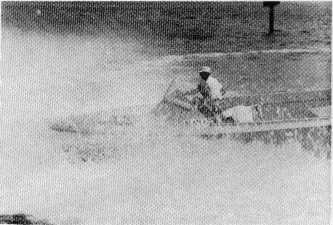
We hope you enjoy our Poems & Stories page, if you have a Poem or Story that you would like to see listed here, send it to The Webmaster.
|
The demands of the boss and his project turned the plant upside down, but the men realized the importance of the program and they gave their all. Key suppliers jumped to Slane's assistance. Special turbo supercharged diesels came from Daytona. Turbo Power Division of Indiana Gear Works supplied the all important water jet pumps. The Morse Control organization adapted their steering system to the peculiarities of the jet drive. A wood deck and cockpit was fitted to the fiberglass hull. The paint was barely dry when she was hoisted aboard a truck for the 200-mile overland trip from High Point, NC, to Morehead City. Willis ran preliminary trials on the craft himself before notifying the Navy. The boat measured up in every respect. With a light load, she exceeded 33 knots. Slow speed maneuvering required some practice. Without a rudder and the positive control of propellers, the boat handled quite differently. However, its turning characteristics at speed were spectacular. This can be seen in the accompanying photographs. Representatives from the Pentagon, Bureau of Ships, and a naval adviser fresh from the Viet Nam theater journeyed to Morehead City to evaluate the boat. Suppliers of the major and featured components were on hand to answer questions and implement any changes. The experts were all reasonably familiar with water jet propulsion and how it has been adapted in recent years to a variety of special purpose pleasure and commercial craft. But they were all surprised to view the rather dramatic performance in Slane's 28-foot hull. Her ability to make a crash stop by reverse deflection of water jets and high speed "end for end" turns are not maneuvers one would attempt to duplicate in a conventional propeller driven hull. Perhaps the boat's most useful feature was her ability to run in very shallow water. At planing speed she drew less than ten inches. When nosed up onto a beach, the powerful jets could back her off with little difficulty. For a number of months, Willis had been in poor health. Having always driven himself hard at anything he was doing, he put forth an extraordinary personal effort on this project. In October, several weeks after the trials, he succumbed at his home in High Point. The Navy was impressed by this interesting boat and purchased her for test and evaluation. Based upon her indicated potential, the Navy developed a performance specification for a complete military gunboat of 28' to 31' l.o.a. The Hatteras Boat Co. and other builders of similar stock fiberglass cruisers were invited to submit proposals to build gunboats to the Navy specification. |
The basic boat for all proposals was to be one of the company's standard hulls thus insuring immediate production capability and avoiding the pitfalls of a completely new untried design. As usual the Navy wanted a lot for its money. The requirements called for a small, fast craft with armament consisting of a twin .50 cal machine gun in an armored turret and a single .30 cal machine gun, plenty of ammunition, and heavy armor protection for the control station. Radio, radar, and boarding party equipment were also required. All of this, along with a requirement for diesel engines and water jet propulsion, provided a sizable challenge to designers and builders of pleasure boats generally concerned with more pleasant features such as live bait wells, fighting chairs, dinettes, etc. To add to the challenge, the Navy wanted their boats in a hurry; 120 boats in less than six months. A number of firms submitted proposals and a contract was awarded to United Boatbuilders Inc., of Bellingham, Wash. This company is a leading West Coast boat builder, selling nationally its line of Uniflite fiberglass boats 17' to 40' in size. It is also a major Navy contractor, having built in fiberglass to naval design and specification many craft as varied as 15' outboards, 52' gas-turbine-powered patrol boats and the 44' sailing yawls of the Naval Academy fleet. United Boatbuilders, under the leadership of their energetic president, Art Nordvedt, with a team of dynamic leading-men, signed a firm fixed price contract for nearly four million dollars to give Navy what it needed. The contract was signed on Nov. 29, 1965 and the first boat was in the water before Christmas. By mid-April all 120 boats had been delivered to the Navy. These boats designated PBR (Patrol Boat River) are a slightly modified version of United's standard 31-foot Uniflite cruiser. The PBR is powered by twin GM 6V53 diesel engines rated at a maximum of 220 hp. each at 2800 r.p.m. Driving a 14" diameter mixed flow waterjet pump manufactured by Jacuzzi Bros. of Richmond, Cal. Weighing in fully loaded at 14,500 lb., a good 50% more than their pleasure boat sisters, the little diesel-powered PBR's are real fighting boats in the PT boat tradition, contributing significantly to our Navy's presence in the river and delta regions of Viet Nam.
|
